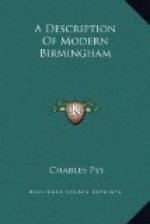Let bright invention rove where no one
awes,
Unfetter’d by dull, narrow, civic
laws,
Which shut out commerce, ingenuity.
Where bloated pride, in sullen majesty,
And drowsy pomp sits notionally great,
While she on every stranger shuts her
gate.
Let ingenuity here keep her seat,
For works minute, or works immensely
great,
We to thy native sons the gift impart,
Of bright invention, and of matchless
art,
Skill’d to devise, to reason, to
compute,
Quick to suggest, and prompt to execute;
What some have but conceiv’d, do
thou amend,
Mature and perfect, to some noble end.
Let fertile genius’ bright, inventive
powers,
In all their vigorous energy be yours.
Let savage nations who thy stores behold,
Give Britain in return, their useless
gold,
Their gems, their pearls, their diamonds
impart,
And boast the change, and prize the gift
of art.
Thus shall thy polish’d wares of
choicer worth,
Gain all that’s rare, from ev’ry
clime on earth.
Thy skill superior let our monarchs own,
And deem thee a bright jewel in their
crown.
OBSERVATIONS
Made during an Excursion
To Wednesbury in Staffordshire, distant eight miles, on the road to Wolverhampton and Shrewsbury.
You proceed down Snowhill, and having passed the one mile stone, there are a few trees close to the road side, and opposite to them there is an extensive view over Barr-beacon, and the adjacent country, including the lofty trees in Aston park; over whose tops, the elegant spire of that church is seen. In descending the hill, when you have passed the buildings, the eye is delighted, on the right hand, with an extensive view over Hunter’s nursery grounds, and on the left is Hockley abbey: this building was erected upon a piece of waste, boggy land, about the 1779, by Mr. Richard Ford, an ingenious mechanic of Birmingham, who, among other things, invented a one-wheel carriage, which he constructed entirely of iron; and for his ingenuity in the formation of that vehicle, the society of arts presented him with their gold medal. As he employed a number of hands, several of whom expended nine or ten shillings each week at the alehouse, it occurred to him, who was not given to drink, that he would lay aside two shillings every day; and having done so for a considerable time, as his business required him to keep a horse and cart; when they were at leisure, he sent them to Aston furnace,[5] to bring away large masses of scoriae, usually termed slag or dross, that lay there in great abundance. Having collected together a large quantity of it, he began to erect this building, to represent ruins; and to add to the deception, there is in the front of the house, in small pebble stones, the date, 1473; and all this was done, as he informed the writer of this article, without




